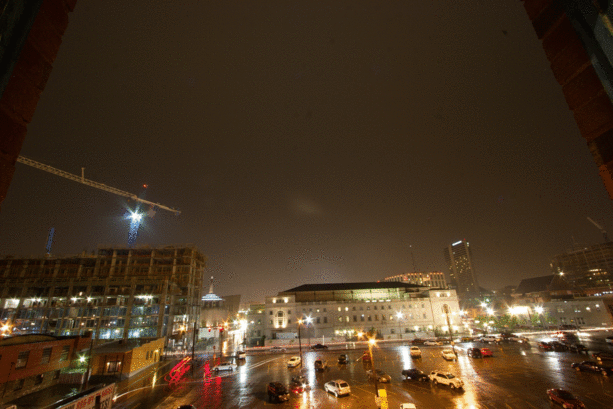Minimalism is a form of music best known for it’s simple harmonies, it’s consonant feel, and it’s drone-like sound. The minimalist movement became very popular in America during the late 20th century but it is composers like Philip Glass, Steve Reich, Terry Riley, and most importantly, La Monte Young that defined and ultimately gave shape to all that is the style of minimalism. La Monte Young is often considered the forerunner and father of minimalism in America, and his masterpiece “The Well-Tuned Piano,” is perfect proof as to why.
“The Well-Tuned Piano” is an interesting piece greatly influenced by mathematical composition. It is a steadily changing composition of themes and improvisations for a solo piano in "just intonation." The concept of just intonation refers to the use of ratios to represent relationships between two notes, contrasting with the standard system of equal temperament, which is the system of tuning comprised of 12 equally-divided steps most common in the Western world of music (what we're accustomed to in America). The piece was composed in 1964 when experimental music was on the rise, and its focus was to demonstrate purely harmonic relationships between notes. The piece most frequently uses the perfect fifth (a ratio of 3:2) and pure minor sevenths (a ratio of 7:4) and every time it is performed, the interpretation seems to take on a life of its own, often lasting durations of over 5 hours.
Listen to the first 10 minutes here:
Young aimed for the piece to be improvisational, having no intention or need for notating it in a score. The only "score" available from Young consists of nothing more than his themes in several different versions, scales and ornamental patterns, as well as the chordal areas he investigates.
“The Well-Tuned Piano” is an interesting piece greatly influenced by mathematical composition. It is a steadily changing composition of themes and improvisations for a solo piano in "just intonation." The concept of just intonation refers to the use of ratios to represent relationships between two notes, contrasting with the standard system of equal temperament, which is the system of tuning comprised of 12 equally-divided steps most common in the Western world of music (what we're accustomed to in America). The piece was composed in 1964 when experimental music was on the rise, and its focus was to demonstrate purely harmonic relationships between notes. The piece most frequently uses the perfect fifth (a ratio of 3:2) and pure minor sevenths (a ratio of 7:4) and every time it is performed, the interpretation seems to take on a life of its own, often lasting durations of over 5 hours.
Listen to the first 10 minutes here:
Young aimed for the piece to be improvisational, having no intention or need for notating it in a score. The only "score" available from Young consists of nothing more than his themes in several different versions, scales and ornamental patterns, as well as the chordal areas he investigates.
___________________________________
Analysis for such a jarring piece may be very difficult because standard notions of analysis prove to be more or less useless. With a varying duration of sometimes 5 hours and no published sheet music, attention must be paid to certain themes and movements that arise throughout the piece in order to begin to understand the overall concept, which involves a great many hints of time, space, and ultimately pitch perception.
Much can be learned when focusing on how The Well-Tuned Piano affects a listener. With Western ears as my own, the sound of the piano itself is enough to make me tilt my head in interest. Young performed his masterpiece on a very carefully and specially maintained Bösendorfer piano set in just intonation. The Bösendorfer has a very dark, rich tone, that when combined with the different harmonies of just intonation, an entrancing and hypnotizing effect is achieved.
From the beginning of the piece, very slow-moving notes are contrapuntally played with much space in between, and they often repeat, instilling an image of staring up at an open sky, watching patterns of clouds move in and out of sight. To me, the beginning is awfully reminiscent to Debussy's Nuages - with a very fleeting sense of harmony present. The just intonation provides pure harmonies to new ears, and it takes a bit of time to realize the lack of "traditional" harmony. Like Debussy's piece, it feels as though there is a constantly evolving or rotating sense of harmony, shifting in and out of focus as the piece drones on. The pure fifths stick out like a sore thumb and the pure minor sevenths don't sound as jarring as one might expect.
Check out Debussy's Nuages, part 1:
There is structure to this improvisational piece, although one might not expect to find it in a performance of over 5 hours. Young explores periods of slow, contrapuntal, harmonic evolution, only to follow it up with a trill-like bombardment of notes. In harsh contrast with traditional structures, Young drones and explores a great deal of harmonies in each one of his sections, greatly varying in length, almost as if eager to hear every possible combination of notes in succession with one another. The sustain pedal is constantly being pressed, making the harmonics of each and every note struck envelope every successive note (particularly in his fast sections), creating a swirl of sound and a definite heightened sense of attention in his listeners.
Each time Young ends his trill-like sections, one might expect the piece to be finished. The ends to these fast-paced parts almost force the listener to close their eyes, as if being lulled to a sense of total security and calmness. When the snail-like and mostly contrapuntal sections return, the idea of dreaming becomes even more apparent. Returning back to the cloud simile, it is as though there are periods of clear skies with interspersed durations of storms, repeating in a steady pattern.
 vs.
vs.
There are moments in The Well-Tuned Piano where Young's tuning system seems to collapse to fresh ears. Sections in which Young explores what sounds like a minor second create the illusion of the notes pulling so hard towards each other that they want to collapse. Here, a chart of Young's actual tuning for the piece explains some of these images:
 In equal temperament (the tuning system common in Western civilization), we are used to hearing a minor second being a 200 cents difference. With just intonation, we see the difference being very different.
In equal temperament (the tuning system common in Western civilization), we are used to hearing a minor second being a 200 cents difference. With just intonation, we see the difference being very different.Listen to just how this scale sounds here.
In Young's tuning, a strange occurrence is that fact that the G# is lower than the G, and the C# is lower than the C. Young's reason for this was so that each perfect fifth (which consists of a 3/2 ratio) would be spelled out correctly on the keyboard he was using.
For a list of some of the interesting chords Young explores in his work, look at page 3 of the pdf found here: www.plainsound.org/pdfs/theWellTunedPiano.pdf
What's more interesting about Young's masterpiece is the performance itself. What began in 1964 as an improvisational outline of about 45 minutes developed into performances reaching over 6 hours sometimes. The endurance that is necessary to complete a performance like this is astonishing by itself. Young's The Well-Tuned Piano will continue to remain as one of the most ground-breaking and intriguing pieces/performance coming from the 1980's. It explores themes of tuning, and more importantly sound in space and time. Listening to an entire performance could be like one giant dream: One that upon waking up, something entirely strange and new had just occurred.
Sources:
"Amazon.com: LaMonte Young: The Well-Tuned Piano 81 X 25, 6:17:50 - 11:18:59 PM
NYC: La Monte Young: Music." Amazon.com. 19 Apr. 2009
http://www.amazon.com/LaMonte-Young-Well-Tuned-Piano-NYC/dp/B000009HZ9
Gann, Kyle. "Just Intonation Explained." Kyle Gann's Home Page. 1997. 19 Apr. 2009 http://www.kylegann.com/tuning.html
Gann, Kyle. "La Monte Young's The Well-Tuned Piano." Kyle Gann's Home Page. 1997. 19 Apr. 2009 http://www.kylegann.com/wtp.html
Gann, Kyle. "La Monte Young's The Well-Tuned Piano." Perspectives of New Music 31 (1993).
"La Monte Young." Wikipedia, The Free Encyclopedia. 30 Mar 2009. 19 Apr 2009
http://en.wikipedia.org/w/index.php?title=La_Monte_Young&oldid=280742939
La Monte Young - The Well Tuned Piano. YouTube. 7 Apr. 2009. 18 Apr. 2009 http://www.youtube.com/watch?v=a7tmxHhcH0w
"MELA: La Monte Young - The Well Tuned Piano press quotes." MELA Foundation. 19
Apr. 2009 http://www.melafoundation.org/quotwtp.htm
